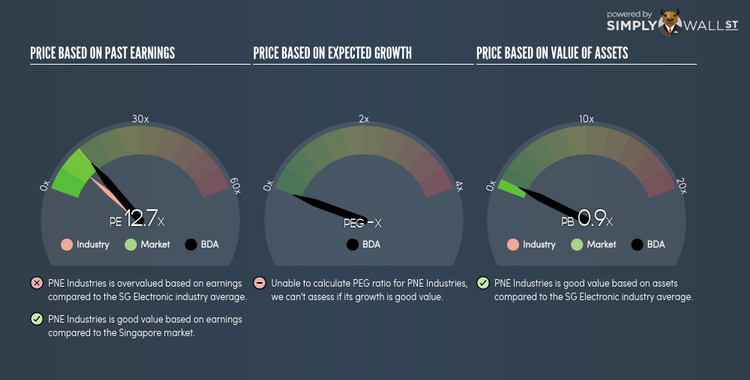Is It Time To Sell PNE Industries Ltd (SGX:BDA) Based Off Its PE Ratio?

PNE Industries Ltd (SGX:BDA) is trading with a trailing P/E of 12.7x, which is higher than the industry average of 9x. While BDA might seem like a stock to avoid or sell if you own it, it is important to understand the assumptions behind the P/E ratio before you make any investment decisions. In this article, I will deconstruct the P/E ratio and highlight what you need to be careful of when using the P/E ratio. View our latest analysis for PNE Industries
Breaking down the P/E ratio
The P/E ratio is one of many ratios used in relative valuation. By comparing a stock’s price per share to its earnings per share, we are able to see how much investors are paying for each dollar of the company’s earnings.
P/E Calculation for BDA
Price-Earnings Ratio = Price per share ÷ Earnings per share
BDA Price-Earnings Ratio = SGD0.83 ÷ SGD0.065 = 12.7x
The P/E ratio isn’t a metric you view in isolation and only becomes useful when you compare it against other similar companies. We preferably want to compare the stock’s P/E ratio to the average of companies that have similar features to BDA, such as capital structure and profitability. A common peer group is companies that exist in the same industry, which is what I use. BDA’s P/E of 12.7x is higher than its industry peers (9x), which implies that each dollar of BDA’s earnings is being overvalued by investors. As such, our analysis shows that BDA represents an over-priced stock.
Assumptions to be aware of
Before you jump to the conclusion that BDA should be banished from your portfolio, it is important to realise that our conclusion rests on two assertions. Firstly, our peer group contains companies that are similar to BDA. If this isn’t the case, the difference in P/E could be due to other factors. For example, if you are comparing lower risk firms with BDA, then its P/E would naturally be lower than its peers, as investors would value those with lower risk at a higher price. The second assumption that must hold true is that the stocks we are comparing BDA to are fairly valued by the market. If this is violated, BDA’s P/E may be lower than its peers as they are actually overvalued by investors.
What this means for you:
If your personal research into the stock confirms what the P/E ratio is telling you, it might be a good time to rebalance your portfolio and reduce your holdings in BDA. But keep in mind that the usefulness of relative valuation depends on whether you are comfortable with making the assumptions I mentioned above. Remember that basing your investment decision off one metric alone is certainly not sufficient. There are many things I have not taken into account in this article and the PE ratio is very one-dimensional. If you have not done so already, I highly recommend you to complete your research by taking a look at the following:
Financial Health: Is BDA’s operations financially sustainable? Balance sheets can be hard to analyze, which is why we’ve done it for you. Check out our financial health checks here.
Past Track Record: Has BDA been consistently performing well irrespective of the ups and downs in the market? Go into more detail in the past performance analysis and take a look at the free visual representations of BDA’s historicals for more clarity.
Other High-Performing Stocks: Are there other stocks that provide better prospects with proven track records? Explore our free list of these great stocks here.
To help readers see pass the short term volatility of the financial market, we aim to bring you a long-term focused research analysis purely driven by fundamental data. Note that our analysis does not factor in the latest price sensitive company announcements.
The author is an independent contributor and at the time of publication had no position in the stocks mentioned.

 Yahoo Finance
Yahoo Finance 
